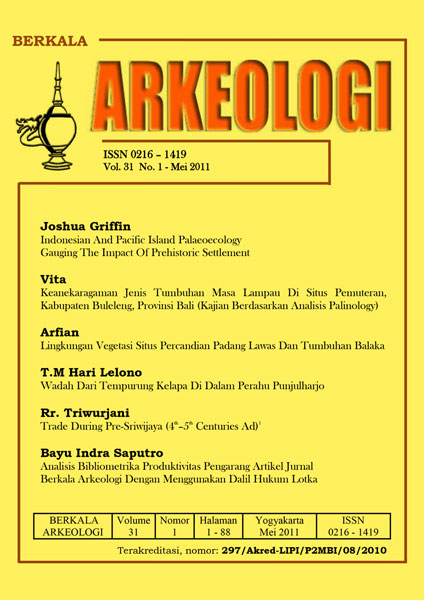INDONESIAN AND PACIFIC ISLAND PALAEOECOLOGY GAUGING THE IMPACT OF PREHISTORIC SETTLEMENT
Main Article Content
Abstract
Anthropogenic optimal foraging models have provided a theoretical foundation for evaluating fluctuations in human resource use, thereby providing archaeology with a platform to present various theories on prehistoric island resource exploitation and habitat alteration. This paper cross-examines three major elements of remains found in island assemblages: those being avifauna, marine fauna, and palaeobotanical remains (from Henderson Island, American Samoa and Hawaii, and eastern Indonesia respectively). In doing so, the sequence of prehistoric resource depression or extinction should be readily identified through this anthropogenic behaviour. However, the Polynesian faunal assemblages shed more light on anthropogenic impact than the palaeobotanical record from Indonesia. Nevertheless, as a comparative study, this information provides a framework for present-day management and the potential restoration of these island ecosystems.
Article Details

This work is licensed under a Creative Commons Attribution-NonCommercial-ShareAlike 4.0 International License.
References
Anderson, A. 1981. A model of prehistoric collecting on the rocky shore. Journal of Archaeological Science 8:109-120.
Anderson, A. 2002. Faunal collapse, landscape change and settlement history in Remote Oceania. World Archaeology 33:375-390.
Athens, J.S. et al. 2002. Avifaunal extinctions, vegetation change, and Polynesian impacts in prehistoric Hawai'i. Archaeology in Oceania 37:57-78.
Behrensmeyer, A.K. 1978. Taphonomic and ecologic information from bone weathering. Paleobiology 4:150-162.
Bulbeck, D. 2008. An integrated perspective on the Austronesian diaspora: The switch from cereal agriculture to maritime foraging in the colonisation of island southeast Asia. Australian Archaeology 67:31-51.
Claassen, C. 1986. Temporal patterns in marine shellfish-species use along the Atlantic coast in the southeastern United States. Southeastern Archaeology 5:120-137.
Claassen, C. 1998. Shells. Cambridge: Cambridge University Press. Ericson, P.G.P. 1987. Interpretations of archaeological bird remains: A taphonomic approach. Journal of Archaeological Science 14:65-75.
Glover, I. & P. Bellwood. (eds). 2004. Southeast Asia: From prehistory to history. New York: Routledge Curzon.
Griffin, J. 2008. Avifaunal remains on Henderson Island: The taphonomy of cultural and natural deposition, Undergraduate research proposal. University of Queensland, St Lucia.
Jackson, J.B.C. et al. 2001. Historical overfishing and the recent collapse of coastal ecosystems. Science 293:629-638.
Keegan, W.F. & J.M. Diamond. 1987. Colonization of islands by humans: A biogeographical perspective. Advances in Archaeological Method and Theory 10:49-92.
Laroulandie, V. 2005. Anthropogenic versus non-anthropogenic bird bone assemblages: New criteria for their distinction, pp. 25-30. in T.P. O’Connor (ed). Biosphere to lithosphere: New studies in vertebrate taphonomy. Proceedings of the 9th Conference of the International Council for Archaeozoology, Durham, England, August 2002, Oxford: Oxbow.
Lyman, R.L. 1994. Vertebrate taphonomy. Cambridge: Cambridge University Press.
Mannino, M.A. & K.D. Thomas. 2002. Depletion of a resource? The impact of prehistoric human foraging on intertidal mollusc communities and its significance for human settlement, mobility and dispersal. World Archaeology 33:452-474.
Morrison, A.E. & D.J. Addison. 2008. Assessing the role of climate change and human predation on marine resources at the Fatu-ma-Futi site, Tutuila Island, American Samoa: An agent based model. Archaeology in Oceania 43:22-34.
Morrison A.E. & T.L. Hunt. 2007. Human impacts on the nearshore environment: An archaeological case study from Kauai, Hawaiian Islands. Pacific Science 61:325-345.
O'Connor, T.P. (ed). 2005. Biosphere to lithosphere: New studies in vertebrate taphonomy. Proceedings of the 9th Conference of the International Council for Archaeozoology, Durham, England, August 2002, Oxford: Oxbow.
O'Connor, S. et al. 2005. The archaeology of the Aru Islands, eastern Indonesia. Canberra: Pandanus Books/ANU E Press.
Spencer, T. & T.G. Benton. 1995. Man's impact on the Pitcairn islands. Biological Journal of the Linnean Society 56:375-376.
Steadman, D.W. 1989. Extinction of birds in eastern Polynesia: A review of the record, and comparison with other Pacific Island groups. Journal of Archaeological Science 16:177-205.
Steadman, D.W. & S.L. Olson. 1985. Bird remains from an archaeological site on Henderson Island, south Pacific: Man-caused extinctions on an "uninhabited" island. Proceedings of the National Academy of Sciences of the United States of America 82:6191-6195.
Wadley, R.L. & C.J.P. Colfer. 2004. Sacred forest, hunting, and conservation in west Kalimantan, Indonesia. Human Ecology 32(3):313-338.
Weisler, M.I. 1994. The settlement of marginal Polynesia: New evidence from Henderson Island. Journal of Field Archaeology 21:83-102.
Weisler, M.I. 1995. Henderson Island prehistory: Colonisation and extinction on a remote Polynesian island. Biological Journal of the Linnean Society 56:377-404.
Weisler, M.I. 2001. On the margins of sustainability: Prehistoric settlement of Ãœtrok Atoll, northern Marshall Islands. BAR International Series 967, Oxford: Archaeopress.
Weisler, M.I. & R.H. Gargett. 1993. Pacific island avian extinctions: The taphonomy of human predation. Archaeology in Oceania 28:85-93.
Wragg, G. 1995. The fossil birds of Henderson Island, Pitcairn Group: Natural turnover and human impact, a synopsis. Biological Journal of the Linnean Society 56:405-414.
Wragg, G. & M.I. Weisler. 1994. Extinctions and new records of birds from Henderson Island, Pitcairn Group, south Pacific Ocean. Notornis 41:61-70.

